Pathfinder Roleplaying Game: Beginner Box by MollyMetroid
Overview
Original SA post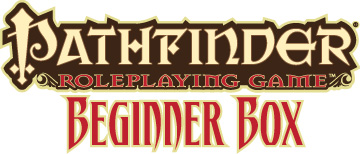
Part 1: Overview
I’m here to talk about the Pathfinder Beginner Box.
First, I want to take a couple of paragraphs to give a bit of an overview. While Alien Rope Burn reviewed the game a few years ago (and it was an excellent review) there’s a couple of points that I want to review before digging into the Beginner Box proper.
The basic history behind Pathfinder is probably pretty well known to readers of this thread, so I won’t go through that. I’m also pretty confident that everyone knows that it’s not the tightest designed game, in that it is built on the framework of 3.5 D&D. It may not be the most groundbreaking of games, but full disclosure, I like it quite a lot despite its flaws.
An important thing to note is that the Pathfinder RPG very much exists to support the Pathfinder Adventure Paths, released monthly, which are the bread and butter of Paizo’s business and what allows them to keep operating. The Adventure Paths, in turn, are designed with the intention that non-optimized groups can get through them without too many issues. They’re basically designed for a group of players who aren’t char-op experts with tons of system mastery, and that leads us to the Beginner Box.
The Beginner Box is one of three points of entry to the Pathfinder Roleplaying Game, alongside the Core Rulebook (weighing in at close to six hundred pages) and the SRD. While the SRD is free and contains basically all the rules from all of the books, it also contains all the rules from all the books. For experienced gamers, either of these can be an approachable product, but let’s be honest--there’s a lot to be said for a box product that can be put on the shelf at say, Target or Walmart or other major retailers, and can introduce the game in a clear and concise way for newcomers. We’ll explore how well it succeeds in further posts, but for now we’ll wrap up this post with a quick summary of the contents of the box.
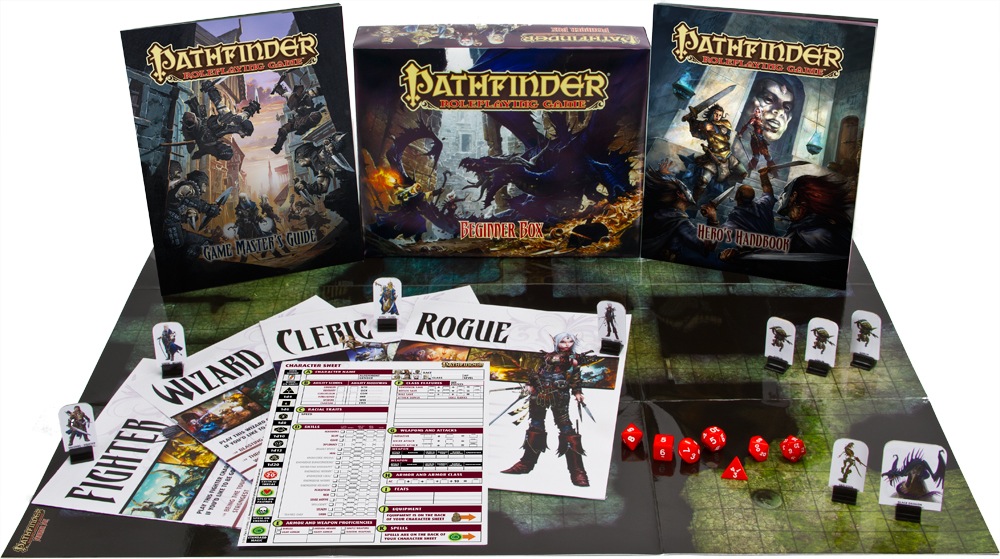
Image shamelessly nabbed from Paizo's product page. The pawn bases don't look like that, but otherwise accurate depictions.
On opening the box, the first things visible are two small baggies--one contains a set of polyhedral dice, in red, the other contains a small number of bases to be used with Pathfinder Pawns. The dice are red with white numbers, and are perfectly serviceable dice. I mean, they’re nothing special but they don’t need to be. Beneath those is a slip of paper labelled “Before you go any further, read this page, as it will help you get started with this box.” It provides suggestions for what to do if you’re on your own but want to experience what a game might be like (turn to the solo adventure in the Hero’s Handbook,) if you want to just be a player and start immediately (grab a pregen and go,) if you want to make your own character (the Hero’s Handbook and a blank sheet,) or if you want to be the GM (the Game Master’s Guide is the starting point.)
Below that there are the aforementioned pregenerated characters, the Hero’s Handbook, the Game Master’s Guide, a Transition Guide with tips on graduating from the Beginner Box to the full game, three sheets of durable Pathfinder Pawns to go with the bases I mentioned earlier, and a double-sided flip mat of good quality. The Pawns and the flip-mat serve as both helpful game aids for the contents of the Beginner Box and a really good hands-on introduction to two of Paizo’s game aid product lines--it’s easy to imagine someone grabbing the Beginner Box, finding the Pawns useful, and buying a Bestiary Box of the things for their own adventures--or buying the Pawn kits for whatever Adventure Path they’re planning to run, for example. The flip-mat, likewise, is higher durability and quality than the simple folded paper maps usually found in this kind of product, and is clearly meant to be able to be written on with wet or dry erase markers and reused. There’s also, finally a one-sheet with ads for the Core Rulebook, Bestiary, Inner Sea World Guide (the setting book for Golarion) and on the reverse, for the Pathfinder Society, the Organized Play group for PFRPG.
Based on the quality of the contents alone I’d call this off to a good start as an introductory product--there’s clear instructions on where to start without assuming that everyone’s going to want to start the same way, high quality game aids that match other products in the game line, and everything a new play group is going to need to get underway. We’ll see how well the books themselves manage to present information on what to do and how to play in future posts. (I'll also try to have more images to break up the text a little bit.)
Next time, we’ll take a look at the pregenerated characters and the Hero’s Handbook!
Pregenerated Characters
Original SA post
Part Two: Pregenerated Characters
One of the minor conceits of D&D 3rd Edition was the idea of the iconic characters. These were characters who appeared in the rulebooks in art and examples, characters of each class, to help give a more unified feel or something. D&D’s artists mostly used it to kill off Regdar, the fighter iconic, in as much art as they could.
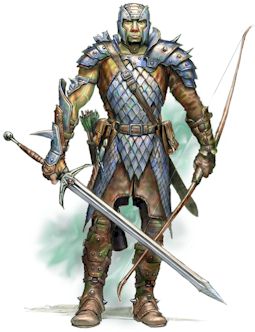
Remember Regdar? He mostly died a lot.
While D&D abandoned the idea after 3.5, Paizo ran with it to an extent that WotC never had, providing articles on their webpage to introduce each new Iconic character for each and every class. They show up in art, in the comics, in the audio dramas, and as pregenerated characters.
One of the reasons I am a fan of Paizo and Pathfinder is that they have always pushed for diversity in their Iconics--Seelah, the paladin iconic, is a badass woman of color, Kyra and Merisiel, the cleric and rogue iconics, are canonically lesbians in a relationship with each other, and Shardra Geltl, the shaman iconic, is a trans woman. It’s really a great bit of inclusivity in an industry where that is either sorely lacking at worst or frequently awkward and misguided. We need not list examples, as everyone in this thread is aware of several recent ones.
The four pregenerated characters in the Beginner Box are the Iconic characters corresponding to the four character classes represented in the Hero’s Handbook--the Fighter, Valeros, the Wizard, Ezren, the Rogue, Merisiel, and the Cleric, Kyra. I can’t find too much to complain about with this selection, since it reflects the classic adventuring party makeup, has 50% female representation, and thanks to Kyra, isn’t just white folks, either. The sheets are full color, folded pamphlets with a portrait of the character on the front page along with suggestions of the types of things that might appeal to potential players about each.
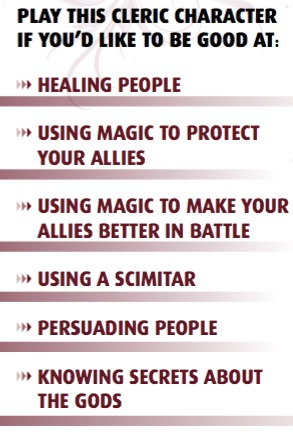
Kyra’s sheet points out that she’s good with a scimitar--not a class feature of the cleric, but of the character in particular.
The main portion of the sheets provide guided tours of what information is found where on the sheet and what it means, and clear explanations on how to use each detail listed.
For example, the main portion for Valeros’ sheet is reproduced below:
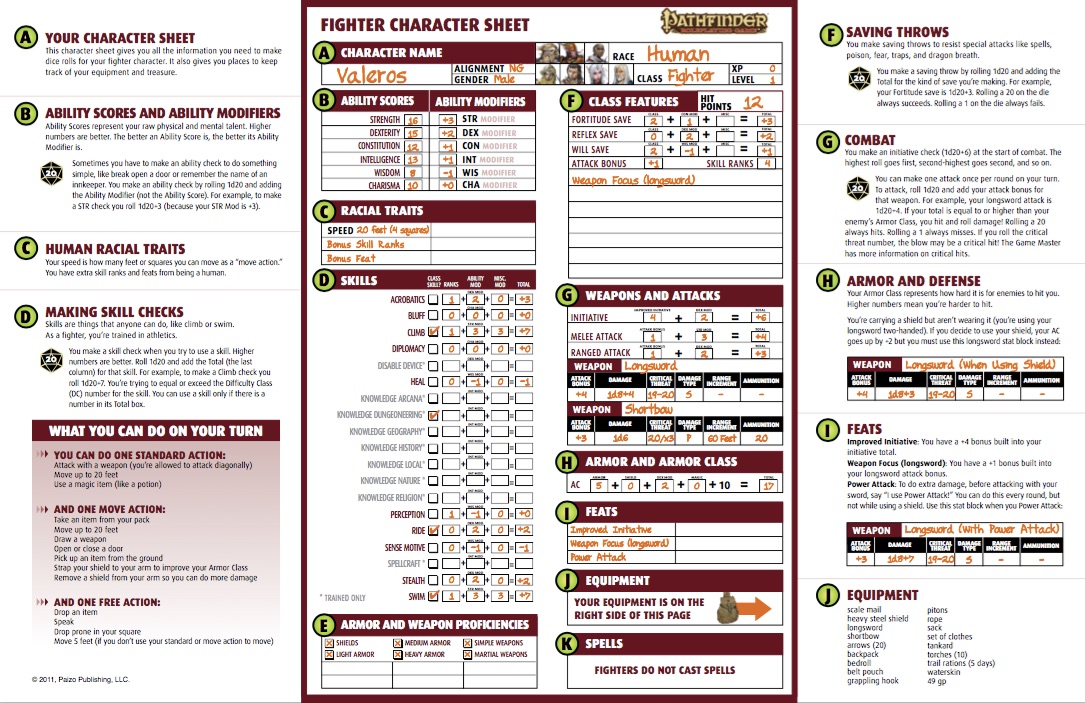
Click to embiggen.
(Paizo has the full set of sheets available for a free download on the product page for the Beginner Box, along with several other free downloads and additional material, incidentally, for anyone interested in seeing the lot of them.)
Valeros is, as I mentioned above, the Iconic Fighter. He’s arguably the simplest of the four characters, and as you can see the sheet includes separate listings for his longsword attack as a default two-handed grip, the power attack, and one-handed with sword and shield. Each of these options is clearly explained as well. Merisiel’s sheet has a simple diagram to explain flanking, for the purposes of sneak attack. The two casters, Kyra and Ezren, have a couple of spells each.
In all honesty I feel like these characters do a good job at their intended purposes. The Fighter is absolutely the best at hitting things with a sword, the Wizard has a couple of flashy spells and a feat that lets him chuck his staff around with magic and use it to hit things from a distance several times a day, and so on--they’re good at feeling like they’re the best in the group at their specialties. The pregens are first level, only go up as far as 5th level (following guidelines in the Hero’s Handbook), and the Beginner Box being a simplified product does not include the full variety of spells--so the problem of the casters outperforming noncasters is very highly mitigated. It’s definitely still true that fighters in the Pathfinder RPG proper are underwhelming compared to other options...but in the Beginner Box, it’s not so much of an issue.
It took more
 to cover the subject of the pregenerated characters than I expected, and the Hero’s Handbook is pretty big, so I will break here and discuss the Hero’s Handbook on its own in the next post!
to cover the subject of the pregenerated characters than I expected, and the Hero’s Handbook is pretty big, so I will break here and discuss the Hero’s Handbook on its own in the next post!
The Hero’s Handbook
Original SA post
Part Three: The Hero’s Handbook
The Hero’s Handbook is the starting point for anyone who wants to make their own character instead of using one of the pregens - a fair enough position to take for an RPG. On the inside cover is a summary of the steps in creating characters. Only three races (human, elf, and dwarf) are represented in the Beginner Box, and only the four classes already spotted in the pregens (that’d be Fighter, Wizard, Cleric, and Rogue.) A positive note, by the way, is that the picture they used to represent the Human race is a headshot of Seelah, the Paladin Iconic character.
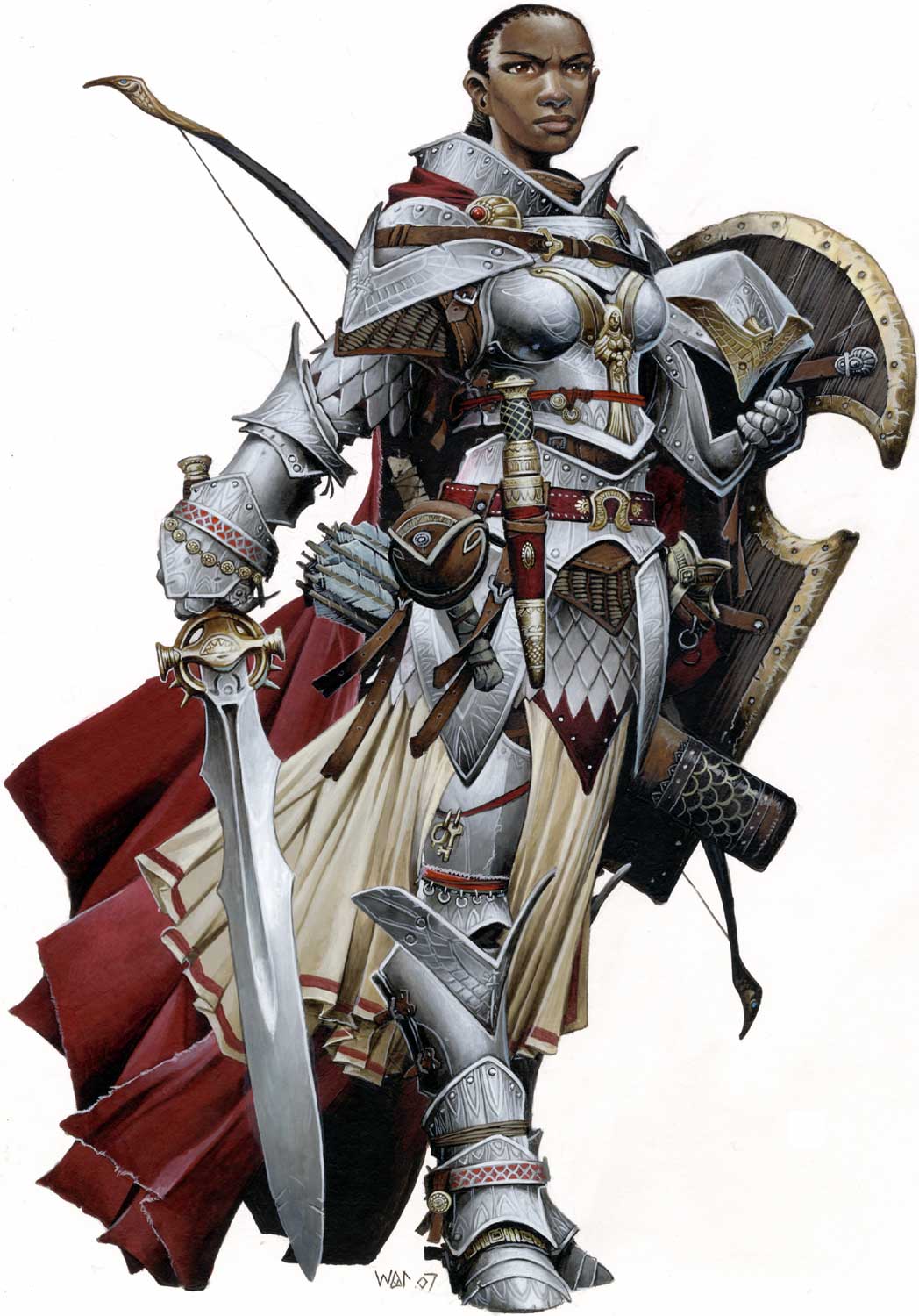
Who is awesome.
Paizo are, as I said, in my previous post, really serious about diversity and inclusivity. It’s one of the things they’re really good at.
Rules, less so:

There are also page references for each step of character creation listed. A handy reference, overall, and in an easily located spot. Next, the book has a brief solo choose your own adventure style introductory adventure of 23 paragraphs - not really a lot of choices, a couple of places where you can die (through combat damage or trap damage plus combat damage) but overall a relatively simple dungeon. You fight a goblin, rescue a captured kid, encounter a trap and a dungeon mold hazard, and defeat a skeleton, then get like 500 gold and a magic sword as a reward. It uses very simplified rules, but gets the point across well enough.
Immediately following this is an example of play - we’ve all seen these. This one is nothing special. Then the remainder of the book is spent on the step by step process of creating a character. This actually covers everything that is needed, clearly outlined at each step, to create a full first level Pathfinder character, albeit with a very limited selection of choices available for spells and feats, and of course, races and classes. That said, by following the guidelines in the book, you’ll basically have a character that could be played alongside characters created with the core rulebook and other supplements. It also has the steps needed to level up to 5th level, and once the guided tour is done, suggested and simplified builds for each class are listed.
There are a total of about 30 feats listed, and maybe a dozen spells for each level of spellcasting that will be reached by wizard and cleric (so a dozen level 1, a dozen level 2, and a dozen level 3 options--a page for each level.) Mostly they are not of the type to render non-casters irrelevant, partly due to the limited selection and partly due to the low level nature of the Beginner Box.
This is one of the most straightforward guides I’ve seen on how to make a simple character. It holds the reader’s hand through the process, never offers so many options as to overwhelm, and gives enough direction that nobody should be coming out of the process with an unplayable wreck, assuming they didn’t roll for shit when they were generating stats. Rolling for stats is honestly the only problem I have with this portion of the Beginner Box, but I hesitate to suggest that point buy would have been a simpler option for new players. A single array of ability scores, built to match a point buy selection that should provide a decent range of high and lows, might have been better, but if rolling for ability scores is the worst sin this box commits it’s still doing better than many of the games covered elsewhere in this thread.
I mean, let’s face it, Beast it ain’t.
The Hero’s Handbook wraps up with an explanation of how PCs do things, including some simplified rules for exploration and a simplified combat system (it doesn’t include, among other things, attacks of opportunity, for example, though critical hits are included and explained clearly.) On the inside back cover there’s a glossary of terms, on the back cover proper there’s a summary of combat sequence and a reprint of the same flanking diagram and roll calculations shown within the book - always nice to have quick reference charts.
I'm not going bother summarizing the character creation rules or the combat rules--I can't imagine that folks aren't familiar with how creating a Pathfinder character works or how combat works in what is basically a D&D clone. Those truly interested can refer to the PRD. The main thing is, the book lays it out clearly and is easy enough to understand that new players should be able to get a game going and, if not get all the rules right (there's a lot to know, after all, even stripped down,) at least have a pretty reasonable facsimile and have a good time with the pack-in adventure..
As an amusing side note, the art in the book is fairly in keeping with Paizo’s standard production values (good, in general.) Remember how I talked about Regdar, D&D 3rd Edition’s Iconic Fighter, dying a lot in art?
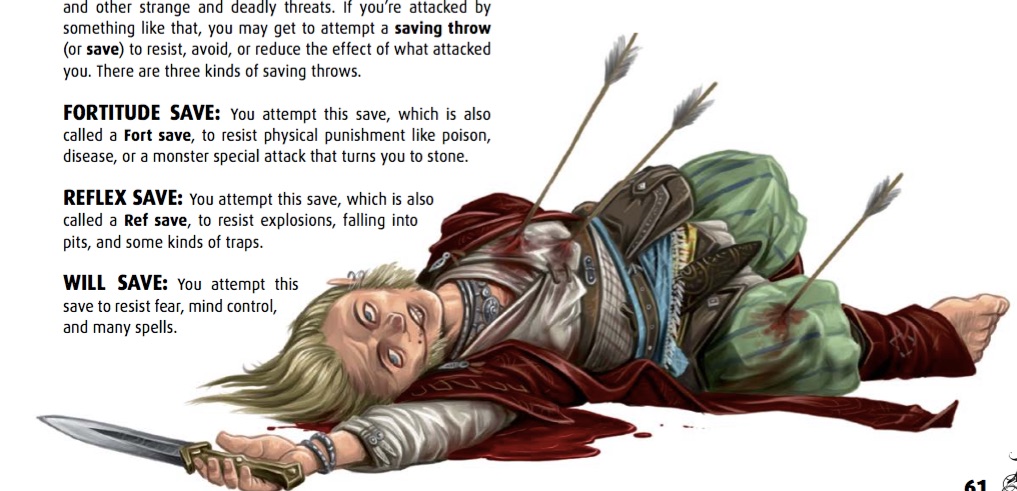
Meet Lem. Lem’s the Iconic Bard for Pathfinder. Unlike Regdar, this isn’t an average day for Lem.
Next time: the Game Master’s Guide.
The Game Master’s Guide
Original SA post
Part Four: The Game Master’s Guide
The Game Master’s Guide (not to be confused with the GameMastery Guide, which is one of the corebooks of the line) is 100 pages, and contains, in no particular order:
A simple ten-room adventure
A sample map and suggested plot to use with it, for novice GMs to populate themselves for a second adventure
Advice and tips on how to plan adventures, run the game, and create new content, including a list of a dozen adventure hooks to get the juices flowing
12 pages of magic items
24 pages of monsters
Sandpoint, a sample town that DMs could use as a base for adventurers, with additional story hooks and a couple of key NPCs.
A few more rules, for environmental hazards and status conditions, plus examples of tasks for common DCs
We’ll tackle this one thing at a time. First, the ten-room adventure. It uses one side of the flip-mat included in the box (the other side is blank, which we’ll come back to later.) The encounters include a pair of goblins that attack the heroes (a simple combat encounter), the room the goblins sleep in (to demonstrate an exploration segment, as there is treasure to be had), a magic fountain that gives random effects - if you throw a coin in before drinking you remove the chance to have negative effects, otherwise you get either a +2 or -2 to something in the next fight, for the most part. Next, a trapped altar (showcasing trap type encounters), a giant spider (a fight with more going on tactically than a straight up slugfest, plus it has poison so can introduce conditions), a magic pillar with some nearby graffiti that offers a hint of what’s to come. The pillar grants a bonus to swimming and allows someone to breathe underwater if it is activated, which comes in handy in the next encounter--a pool of water with a nasty crab-monster hiding in it, but the most important treasure in the dungeon on the other side: a +1 dragon-bane longsword. And some potions and stuff, but really the sword is the one thing that’s going to make or break a party in this adventure. Then there’s a roleplay encounter with some goblins - you can fight ‘em or parlay with ‘em--and after that a set of skeletons guarding the final room of the dungeon, which is the lair of a young black dragon--that sword makes sense now, yeah?
I like a lot of things about this as an introductory dungeon. It does a very good job of having a variety of different things to show a new GM that there’s more than just fights to worry about. The goblins in the roleplay encounter can be dealt with by just killing them, or by finding a missing goblin (the giant spider killed her and she’s where the treasure in that encounter is from.) The dragon at the end is a tough fight, but it’s also made explicit that it doesn’t have any interest in dying - if the party does 25 damage (of 54 hit points) or hits it even once with that magic sword, it will flee to fight another day. It is suggested that it sticks around for at least two turns, but I really like that it sets up a recurring antagonist in the first adventure who will have a reason to go after the heroes and who the heroes will have a reason to go after. It also suggests half-a dozen possibilities of what to do next.
Which is another great thing about this Game Master’s Guide - it is not shy about providing adventure ideas. There are probably two dozen or more seeds throughout the book for adventures to get the novice GM thinking about what to do next. The book specifically points out as well that your job is not to “win” but to make sure everyone has fun, and so on.
There’s a section on building a dungeon, with a sample map given:
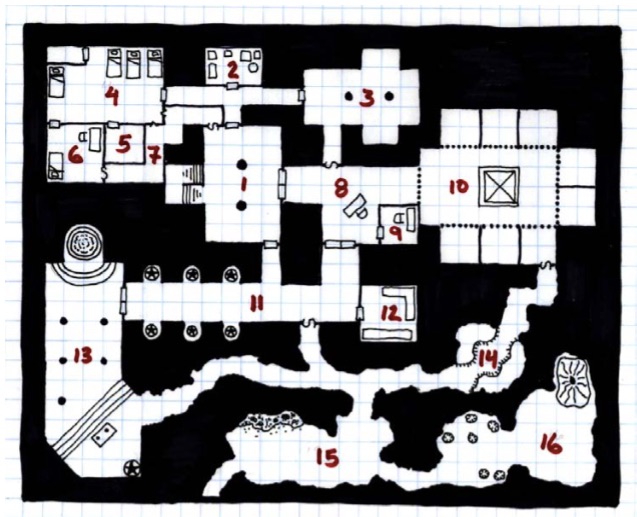
Not coincidentally this map is of perfect dimensions to be copied to the flip-mat. The guide also lists types of encounters (combat, roleplay, obstacle, story, etc) and how to set them up, along with rewards for them like treasure and experience. The section concludes with a short description of a dungeon, Raven’s Watch, the map for which is above--though the specific details of the map are left 100% to the GM.
I can’t say enough how cool I think that part is. For a D&D style game, building dungeons is often the meat and potatoes--and this Beginner Box not only provides a solid example dungeon with the full gamut of encounters, but follows it up with something that will allow a novice GM to get their feet wet a little more gradually than just diving right in from there.
Next there’s a section about different environments and what one might encounter there--dungeons, forest, deserts, mountains, swamps, and cities. The dungeon section includes rules for traps, breaking doors, and several environmental cues. The wilderness types are short and include rules for traversing them or terrain hazards. The section on cities talks about shops, laws, and several urban environments (including sewers, of course, because there’s always a sewer level.)
Next, 12 pages of magic items. It’s a limited selection, but covers the bases pretty well. Each item has a small illustration to accompany it, but very little fluff text or examples of how to flesh out magic item history--this isn’t actually all that uncommon in these style of games though, so it’s fair enough.
Following that, 24 pages of monsters--there’s a quick guide to reading their statblocks, and another reminder that combat isn’t always the best or only option heroes can take even with aggressive or evil foes. The Pawns included in the box provide a set of minis for each of the monsters listed in this section as well, which is very nice.
There’s a section following the monster list about random encounters, with a number of encounter tables provided for different environments. The following section of advice is also present here:
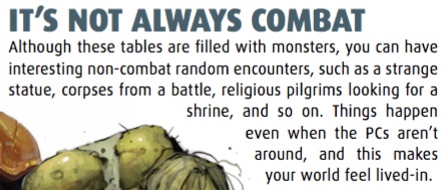
That’s something like the third or fourth time that’s been pointed out, and I really do appreciate it being there in a product like this, because it’s all too easy (especially with video games being a dominant form of exposure to this sort of genre for many people) to forget for tyro GMs.
The next section is Sandpoint, and it is not given tons of detail. There’s a map, a couple of key NPCs listed (the mayor, the innkeeper Ameiko Kaijitsu, the town priest, a couple of other suggested NPCs for each of the four classes to interact with) and a list of local adventure hooks.
Worth mentioning is that Sandpoint is the starting town for not one but two Adventure Paths, including the very first, Rise of the Runelords, and later the ninth, Jade Regent. In both adventures Ameiko Kaijitsu features prominently, largely because she is one of the developers’ former PCs, which is why I called her out by name in particular. Sandpoint is also featured in the Goblin themed adventures that Paizo produces for Free RPG Day. (So far there are three available in pdf for free from Paizo’s site, with a fourth due out this year as well.) None of this is mentioned in the Beginner Box, mind you, but it’s a neat little nod.
Then, a section on conditions (stunned, poisoned, sickened, unconscious--all the nasty things that the game lets you do to your foes or your players depending on which side of the board you’re on) which is illustrated with examples provided by the distinctive Pathfinder goblins for each condition. These are cute as hell, but not always the most illustrative--the disabled goblin below represents having 0 HP but being stable or conscious--doing any standard action causes damage, and if you’re still at negative HP you go unconscious and begin dying. That’s not what I get out of that illustration, but, most of the others are better.
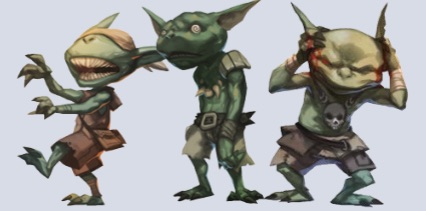
Blinded, disabled, and deafened goblins.
Then wrapping up the book, the last page is “where to from here”, with suggestions being another free adventure, an additional bonus class (the barbarian), and some other free resources from the Paizo site for the beginner box specifically, as well as the Core Rulebook, the Bestiary, and the Inner Sea World Guide for setting details on Golarion.
On the inside rear cover is a pretty standard set of hand-drawn map symbols that should be familiar to anyone who’s ever designed a dungeon for a D&D style game, and on the rear cover exterior is another reference page with several more common conditions and a diagram illustrating the cover rules.
And that’s the Game Master’s Guide. Since I covered the flip-mat in this particular post for the most part, that leaves for further discussion the pawns and the Transition Guide, which I will discuss next post, and the supplemental downloadable freebies from the Paizo site, which I will examine if people are sufficiently interested as well.
Next time: The Transition Guide
The Transition Guide
Original SA post
Part Five: The Transition Guide
The Transition Guide is, to my understanding, an addition to the Beginner Box that was not originally included in the product at launch--it was added to reprints, but it was also a free download on the beginner box page. It’s short, at under 20 pages, but it’s a valuable addition to the box.
The first thing in the booklet is a list of rules that were skipped or simplified in the BB proper: Opportunity Attacks, disarm/grapple/trip, with CMB and CMD, base attack bonus (which is more simplified than absent,) monster templates, bonus types and how they interact, hit dice, taking 10 or 20, armor rules (which are simplified in the beginner box, not having max dex bonus or spell failure rules), creature sizes, multiclassing, ability damage, concentration (in the BB, casters can’t be adjacent if they want to cast at all,) and languages.
The booklet also suggests that good places to start looking for other options to add to the game compared to the beginner box are the races, classes, and feats sections -- makes sense, all of those areas are very simplified in the Beginner Box and all of them are pretty simple to pick and choose things to add from the core rules without making things too much more complicated.
The next two sections are how to read the non-simplified spell and monster statblocks. Not especially exciting. There’s a section on how to level Beginner Box characters from level 5 to level 6, adding a couple of things where they had been simplified (clerics getting domain spells, for example, or the fighter’s armor training, the rogue’s uncanny dodge, arcane and opposition schools for the wizard, plus the scribe scroll bonus feat)
The next, and final section, takes an adventure that is downloadable free from Paizo’s site, Master of the Fallen Fortress--which was designed for the core rules--and provides guidelines on how to read it and how to adapt it to work for the Beginner Box, or just run it as a full adventure--it’s a little bit different as it was not written with the expectation of being a beginner’s product specifically.
In a few places in this transition guide, it’s pointed out that you can take what you like and leave the rest from the core rules or any other Pathfinder product. It’s a nice touch to reiterate that!
The back inside cover houses advertisements for the Adventure Paths, the fiction line, the campaign setting line and the accessories products, plus a plug for the subscription options and for paizo.com. The back cover is an ad for the Pathfinder Society, the Organized Play setup for Pathfinder.
The Pawns
One thing I didn’t spend much time talking about in this box was the Pawns. These are sturdy cardboard miniatures, basically--there’s several sheets of them, they have solid art that matches their bestiary entries, they’re in the same scale as a standard heroic-scale 32mm mini would be--they play nicer, in my opinion, with said minis than the pog-like tokens that come in most beginner boxes for games of this type. There’s not much to be said here beyond that--they’re a nice accessory, and I’d actually legitimately consider buying these if I were running Pathfinder in person, as they come in both bestiary boxes, that provide pawns for every creature in one of the five Bestiaries printed to date, and in Adventure Path kits, for many (but not all) of the Adventure Paths with baaaasically everything you’re gonna need for those paths. Which is nice because they can get fairly obscure at times.
Closing Thoughts
The Pathfinder Beginner Box is, for a product aimed at beginners, certainly among the best, if not the best overall, that I have seen. All of the books provide clearly laid out and accessible information without overloading the reader, the Game Master’s Guide provides a full adventure and the structure of a second, plus dozens of hooks for further ideas, the Transition Guide provides a third adventure among tips for graduating to the full game, and the accessories are fantastic, especially compared to similar products. The right elements are emphasized in the right places to make this a good starter product, and the free support on the website gives even more playability. It’s got great production values, as most of Paizo’s products do, and overall I am left with a positive impression. It’s also got a lot of information on where to go next, and excellent samples of the accessories Paizo offers. Overall, while this is probably not a product that is really aimed at experienced gamers, there’s enough there to make it a good point of entry for Pathfinder. Which is, after all, the point.